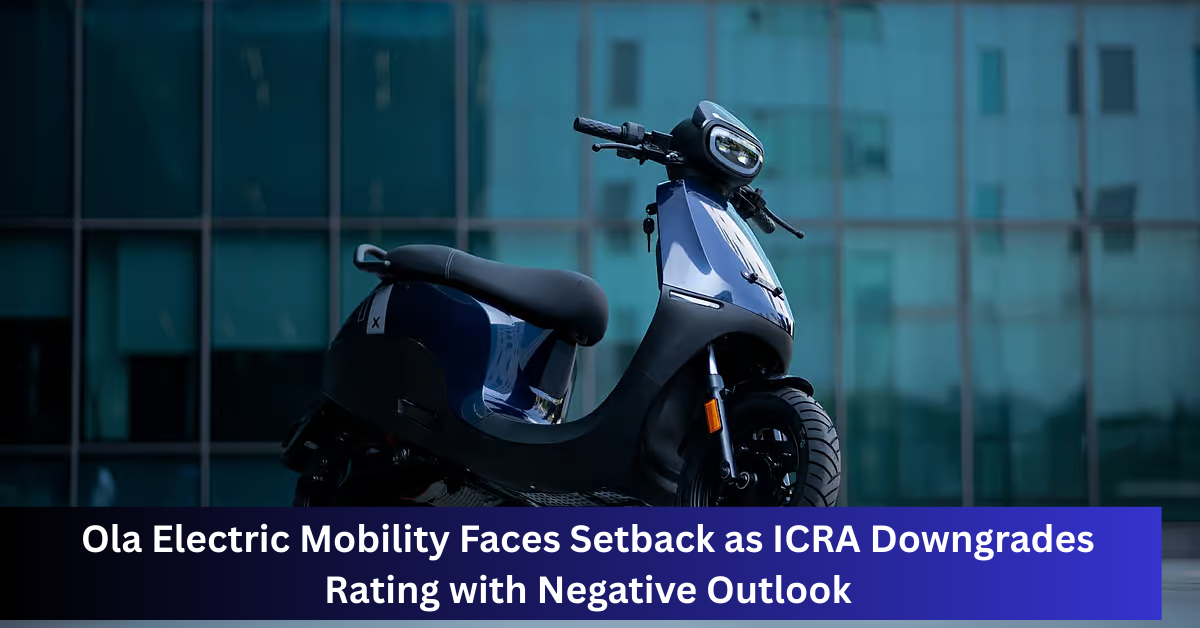Ola Electric Mobility has received a major blow as credit rating agency ICRA downgraded its long-term credit rating and maintained a “negative outlook” on the company. This downgrade raises questions about the company’s financial health, future growth, and ability to deliver on its promises in the highly competitive electric vehicle (EV) market in India.
ICRA, in its official note, stated that the rating downgrade was due to Ola Electric’s parent company’s weakening credit profile. The core reasons behind this include the company’s poor performance in its automotive business, rising competition in the EV space, and its longer-than-expected timeline to reach profitability.
Rising Competition and Delayed Profitability
Ola Electric was once seen as a strong frontrunner in India’s EV market, especially in the two-wheeler segment. However, the environment has changed drastically over the last year. New and established players are entering the EV space with aggressive strategies, better products, and improved service offerings.
According to ICRA, Ola Electric’s struggle to keep up with this increased competition is affecting its financial performance. Despite big plans and high investments, the company has not been able to reach profitability as quickly as expected. This slower pace is a major factor behind the rating downgrade.
ICRA emphasized that the automotive unit of Ola Electric is facing pressure on multiple fronts – increasing market competition, pricing challenges, and a longer gestation period for turning profitable. All of this has added to the uncertainty surrounding the company’s long-term stability.
Ola Cell Technologies and Battery Manufacturing Challenges
Along with its EV business, Ola has also invested in battery manufacturing through its subsidiary, Ola Cell Technologies. The company began battery production in March 2023 with a capacity of 1.4 GWh. While this move was expected to give Ola a cost and supply chain advantage in the EV space, the actual integration of these batteries into its products is still months away.
ICRA has raised concerns about the timely execution of Ola’s battery cell plans. The integration of in-house batteries into its vehicles may take several more quarters. This delay could push back Ola’s ability to reduce costs and improve profit margins, which were expected benefits of the battery production unit.
Moreover, battery cell manufacturing is not an easy task. It involves advanced technology, skilled manpower, and smooth access to raw materials – many of which are imported. Ola Cell Technologies is currently exposed to multiple risks, such as project delays, uncertain demand, and geopolitical instability in sourcing materials like lithium, cobalt, and nickel.
Heavy Capital Investments and Execution Risks
ICRA also pointed out that Ola Electric has heavy capital expenditure (capex) plans for the medium term. While these investments are necessary for long-term growth, they also bring several financial risks. If the execution of these projects is delayed, or if demand doesn’t meet expectations, the financial pressure on the company could increase.
The agency flagged that the scale of the planned investments, combined with uncertain timelines for profitability, could further strain the company’s balance sheet. In a fast-changing market like EVs, delays in delivery or technology rollouts can significantly impact consumer trust and investor confidence.
Support from Parent Company and Government Incentives
Despite the downgrade, ICRA also noted some positives. Ola Cell Technologies and Ola Electric Mobility continue to receive strong operational and financial support from their parent company. This ongoing backing provides a cushion in case of short-term financial needs or liquidity issues.
Additionally, Ola’s battery unit is one of the few Indian companies with an early-mover advantage in lithium-ion battery manufacturing. This gives the company a potential edge in the long term, especially as India pushes for domestic battery manufacturing to reduce reliance on imports.
Ola Cell Technologies is also eligible under the Production Linked Incentive (PLI) scheme for Advanced Chemistry Cell (ACC) battery storage. This government scheme provides financial support and incentives to companies working on advanced battery tech. If Ola can meet the scheme’s milestones, it could help improve project returns and overall profitability.
Liquidity Status and Market Performance
According to ICRA, Ola Electric’s liquidity position is currently adequate. This is mainly because of regular capital infusion from the parent entity, which ensures the company can meet its short-term operational and financial obligations.
However, Ola’s market performance tells a different story. The stock ended 0.3% lower on Friday at ₹48.53, a steep 37% fall from its initial public offering (IPO) price of ₹76. The continued decline in share value reflects investors’ growing concerns over the company’s ability to deliver on its promises.
Market watchers are closely observing how the company manages its operational execution, cost control, and future product rollouts. The next few quarters will be crucial for Ola Electric to regain investor trust and stabilize its business operations.
What Lies Ahead for Ola Electric?
The downgrade from ICRA is a clear sign that Ola Electric is at a critical point in its journey. While the company has taken bold steps by investing in battery production and expanding its EV product line, the road to success is proving more difficult than expected.
The next steps for Ola Electric should focus on faster execution of its battery integration plans, improving the performance of its vehicles, strengthening customer service, and reducing losses. The company must also ensure that its upcoming capex projects stay on track and deliver value.
There’s no doubt that India’s EV market has massive potential. Government support, rising fuel costs, and increasing environmental awareness are pushing more people towards electric mobility. Ola Electric has the brand power and infrastructure to be a market leader, but success will depend on how well it manages execution and competition.
If Ola can fix its operational challenges, win back consumer trust, and start turning profits, it may recover from this rating setback. But if delays continue and market pressure increases, the negative outlook may soon turn into more serious financial concerns.

Deepak Grover is a dedicated content writer at OTE News, specializing in government affairs, public policy, and current events. With a keen eye for detail and a passion for factual reporting, he ensures readers receive accurate and insightful news. Deepak holds a degree in Political Science and has experience in research-driven journalism.
When not writing, he enjoys reading historical books, exploring hiking trails, and staying updated with global political trends. His commitment to ethical journalism makes him a trusted voice at OTE News.




